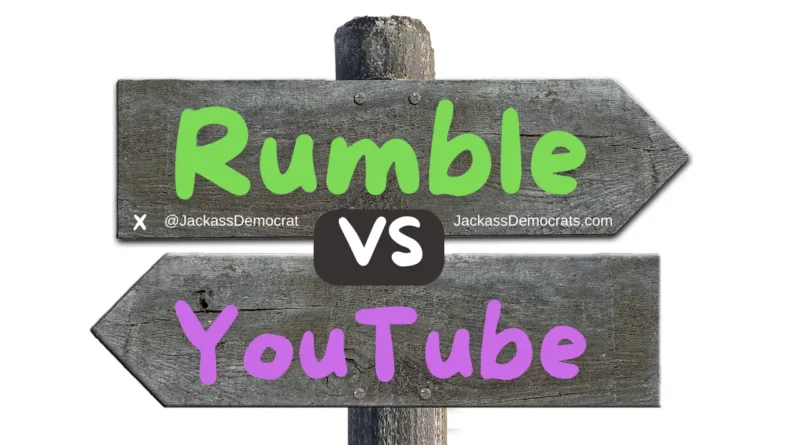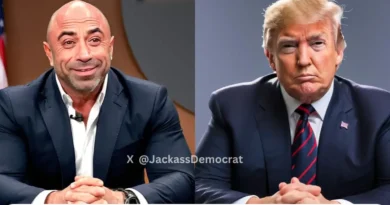Rumble vs YouTube
The Differences Between Rumble And YouTube: A Detailed Comparison
Table of Contents
Introduction
“Rumble vs. YouTube: The Battle for Free Speech and Public Opinion”
Rumble vs YouTube. Basically it’s like Right vs Left. The digital age has given rise to numerous platforms for sharing videos and content, with YouTube historically dominating the scene. However, the emergence of Rumble has sparked discussions about censorship, freedom of speech, and the influence of tech giants on public opinion. This article explores the differences between Rumble and YouTube, delves into the controversies surrounding the censorship of conservative views on YouTube, and examines why censorship, in general, can be problematic.
The Platforms: An Overview
YouTube is a household name, a platform that started in 2005 and quickly became the go-to site for video sharing. Owned by Google, YouTube boasts billions of users and a vast library of content ranging from entertainment to education, news, and more. It has long been a propaganda site of sorts for the democrat party. They censor heavily any speech or ideas they deem goes against the leftist agenda.
Rumble, on the other hand, is a newer entrant, established in 2013. It has gained popularity as an alternative to YouTube, particularly among conservatives who feel that their views are being censored on other platforms. Rumble promotes itself as a site that champions free speech and unbiased content sharing.
Censorship of Conservative Views on YouTube
Rumble vs YouTube. One of the most problematic and unethical issues surrounding YouTube is its approach to moderating content, which many conservatives argue amounts to censorship. This stems from several incidents where YouTube has demonetized, removed, or limited the visibility of videos that espouse conservative viewpoints.
Instances of Censorship
- Demonetization: Conservative content creators often report that their videos are demonetized, meaning they cannot earn ad revenue. This has been a significant issue for channels that rely on this income.
- Content Removal: Videos discussing controversial topics from a conservative perspective have been removed under guise of YouTube’s biased policies against hate speech, misinformation, and harmful content. Critics argue that these policies are applied selectively, disproportionately affecting conservative voices. Liberal views routinely violate the so called policies but are allowed to do so unmolested.
- Algorithmic Suppression: For years conservative creators complain about the fact that YouTube’s algorithms suppress their content, making it less likely to appear in search results or recommended videos, thereby reducing their audience reach. YouTube is owned by Google so naturally the largest search engine and video platform work in tandem to hide conservative viewpoints.
Examples
- Steven Crowder: The conservative commentator has faced multiple suspensions and demonetizations, particularly after conflicts with Vox journalist Carlos Maza, who accused Crowder of harassment.
- PragerU: This educational non-profit organization has had many of its videos restricted or demonetized, despite arguing that their content is educational and not harmful.
The Problems with Censorship
Rumble vs YouTube. Censorship, regardless of the intention behind it, can have several negative consequences:
- Stifles Free Speech: The most immediate concern is the restriction of free speech. By censoring content, platforms can limit the diversity of viewpoints and suppress minority opinions.
- Erodes Trust: Users may lose trust in platforms that are seen as biased or as having an agenda as Youtube and Google has had. This can lead to a decline in user engagement and migration to alternative platforms.
- Echo Chambers: Censorship can contribute to the formation of echo chambers, where people only engage with content that aligns with their existing beliefs, thereby reinforcing polarization.
- Slippery Slope: Once censorship starts, it can become challenging to draw clear lines, potentially leading to broader and more subjective restrictions over time.

Rumble vs. YouTube: Pros and Cons
Rumble vs YouTube. To better understand the appeal of Rumble as an alternative to YouTube, it is essential to compare the strengths and weaknesses of both platforms.
YouTube
Pros:
- Massive Audience: YouTube’s user base is vast, providing content creators with access to a global audience.
- Monetization Opportunities: With various revenue streams, including ad revenue, channel memberships, and Super Chats, YouTube offers robust monetization options for creators.
- Advanced Features: YouTube offers numerous features like live streaming, community posts, and detailed analytics, enhancing the creator and viewer experience.
Cons:
- Censorship Concerns: As discussed, YouTube’s content moderation policies have led to allegations of censorship, particularly from conservative voices. YouTube is not a fair and balanced platform.
- Algorithmic Bias: The algorithms that power YouTube’s recommendations and search results are skewed, leading to gross bias and manipulation.
- Ad Revenue Dependency: The reliance on ad revenue can be problematic, especially when videos are demonetized without clear reasons.
Rumble
Pros:
- Free Speech Focus: Rumble promotes itself as a platform that upholds free speech and resists censorship, making it attractive to those who feel marginalized on other platforms.
- Growing Audience: While smaller than YouTube, Rumble’s user base is growing, particularly among those seeking alternative viewpoints.
- Monetization: Rumble offers monetization options, including a revenue share model and the ability to license videos to other platforms.
Cons:
- Smaller User Base: Compared to YouTube, Rumble’s audience is significantly smaller, which can limit exposure and audience reach for the time being.
- Feature Limitations: Rumble lacks some of the advanced features available on YouTube, which can be a drawback for creators used to YouTube’s robust tool set.
- False Accusation of Bias: While promoting free speech, Rumble is accused by liberals of catering primarily to conservative audiences, which can deter users with different viewpoints. This is not the case though, as Rumble allows all viewpoints, Conservative as well as liberal.
Shaping Public Opinion
Rumble vs YouTube. One of the most significant criticisms leveled against YouTube is that it shapes public opinion by controlling the flow of information. They work hand in hand with the democrat party to censor and control the information that the public is allowed to see. Through content removal, demonetization, and algorithmic adjustments, YouTube can influence what content becomes popular and what remains obscure.
Content Moderation Policies
YouTube’s content policies are designed to protect users from harmful content. However, these policies are often criticized for being overly broad and inconsistently enforced. The subjective nature of terms like “hate speech” and “misinformation” means that enforcement can vary, leading to claims of unfair targeting of certain viewpoints. In essence, YouTube censors opinions they and the democrat party disagree with.
Algorithmic Influence
YouTube’s algorithms play a crucial role in determining what content users see. These algorithms prioritize engagement, often promoting sensational or emotionally charged content. While this drives viewership, it can also skew public perception by amplifying certain narratives over others.
Rumble vs YouTube
Conclusion
The differences between Rumble and YouTube highlight the broader debate about free speech, censorship, and the power of tech giants in shaping public opinion. While YouTube offers unparalleled reach and advanced features, its content moderation policies amounting to extreme censorship, has sparked significant controversy, particularly among conservative voices. On the other hand, Rumble, with its focus on free speech, provides a compelling alternative but faces challenges in terms of audience size and feature set.
Elon Musk bought Twitter and as a result took away one of the democrat party’s largest censorship and propaganda sites. He turned it around and has returned Free Speech to the platform, X.com as it is now known. There were reports of X joining with Rumble, which would be a great event if it ever happened. Rumble needs an influx of energy like Elon Musk adds to any venture he joins. We can only hope Rumble finds a way to speed up their acquisition of market share. Because the world deserves better than the democrat party’s propaganda outlets such as YouTube, Google and others.
Fascism is the word of the day when we speak of how the democrats control most social media and news outlets. Ultimately, the issue of censorship on platforms like YouTube underscores the importance of transparency, consistency, and the protection of free speech. By allowing viewers to access a broad range of viewpoints and make informed decisions, platforms can foster a healthier, more inclusive public discourse. Like FOX News use to say, we report, you decide, before they went to the left, that’s how it should be. People should be allowed to see all the information and decide for themselves, rather than to be told what to think by the democrat party and their propaganda outlets.




